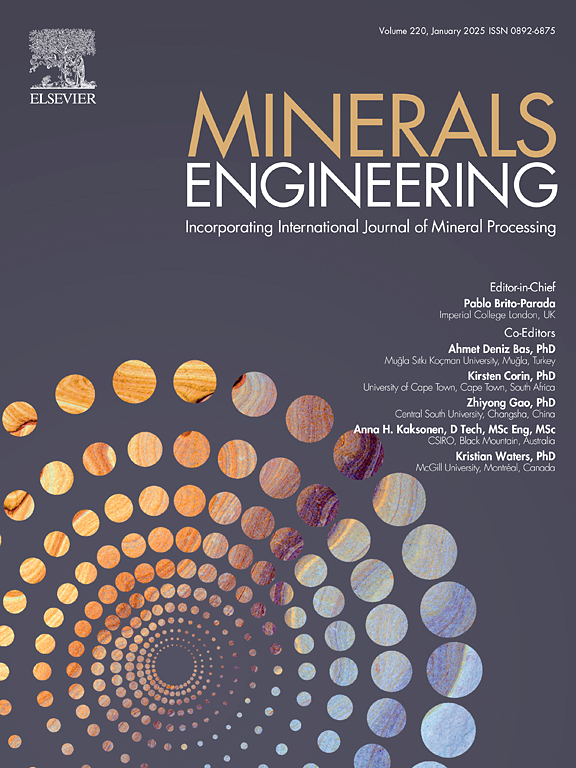通过并行分支网络和混合损失监督优化浮选泡沫图像分割
IF 4.9
2区 工程技术
Q1 ENGINEERING, CHEMICAL
引用次数: 0
摘要
浮选是精煤分选的关键技术,在浮选过程中准确获取气泡尺寸信息对于监测浮选条件和实现智能控制至关重要。然而,现有的语义分割模型在分割浮选气泡时遇到了边界断开的问题,导致提取的气泡尺寸与真实值存在偏差。为解决上述难题,我们提出了一种语义分割模型,通过设计并行分支网络结构,在整个网络中保持高分辨率的特征图。此外,还提出了一个 ConvTranspose 模块,以保留图像的详细特征信息,同时逐步提高特征图的分辨率。在模型训练阶段,提出了一种将像素分类损失与形状相似性损失相结合的混合损失函数,以缓解气泡边界与气泡内部像素数量相差悬殊所导致的样本不平衡问题。此外,由于传统的语义分割评价指标(如 MIoU)缺乏衡量气泡边界连续性的机制,不能有效地惩罚边界断开的问题,因此本文提出了一种新的评价方法来评估浮选泡沫图像的分割性能。为了全面评估所提方法的有效性,本文使用从实际生产过程中采集的浮选泡沫图像进行了测试。与现有方法相比,本文提出的分割模型在缓解气泡边界断开问题方面表现出明显的优势。气泡数量的预测误差为 6.38%,明显优于其他方法。本文章由计算机程序翻译,如有差异,请以英文原文为准。
Optimizing flotation froth image segmentation via parallel branch network and hybrid loss supervision
Flotation is a crucial technology for fine coal separation, and accurately acquiring bubble size information during the flotation process is essential for monitoring flotation conditions and achieving intelligent control. However, existing semantic segmentation models encountered issues with boundary disconnection when segmenting flotation bubbles, resulting in deviations between the extracted bubble sizes and their true values. To address the aforementioned challenges, a semantic segmentation model was proposed to maintain high-resolution feature maps throughout the network by designing a parallel branch network structure. Additionally, a ConvTranspose module was proposed to preserve the detailed feature information of images while gradually enhancing the resolution of feature maps. In the model training phase, a hybrid loss function combining pixel classification loss with shape similarity loss was proposed to alleviate the sample imbalance problem caused by the substantial difference in the number of pixels between bubble boundaries and the interior of bubbles. Moreover, since traditional semantic segmentation evaluation metrics, such as MIoU, lack a mechanism for measuring bubble boundary continuity and cannot effectively penalize the problem of boundary disconnection, this paper proposed a new evaluation method for assessing the segmentation performance of flotation froth images. To comprehensively evaluate the effectiveness of the proposed method, this paper conducted tests using flotation froth images collected from actual production processes. Compared with existing methods, the segmentation model proposed in this paper exhibited clear superiority in mitigating the problem of bubble boundary disconnection. The prediction error for the number of bubbles was 6.38 %, which is significantly better than other methods.
求助全文
通过发布文献求助,成功后即可免费获取论文全文。
去求助
来源期刊

Minerals Engineering
工程技术-工程:化工
CiteScore
8.70
自引率
18.80%
发文量
519
审稿时长
81 days
期刊介绍:
The purpose of the journal is to provide for the rapid publication of topical papers featuring the latest developments in the allied fields of mineral processing and extractive metallurgy. Its wide ranging coverage of research and practical (operating) topics includes physical separation methods, such as comminution, flotation concentration and dewatering, chemical methods such as bio-, hydro-, and electro-metallurgy, analytical techniques, process control, simulation and instrumentation, and mineralogical aspects of processing. Environmental issues, particularly those pertaining to sustainable development, will also be strongly covered.
 求助内容:
求助内容: 应助结果提醒方式:
应助结果提醒方式:


